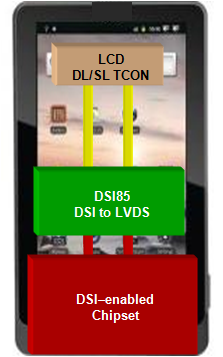JAJSFO0G september 2012 – october 2020 SN65DSI85
PRODUCTION DATA
- 1
- 1 特長
- 2 アプリケーション
- 3 概要
- 4 Revision History
- 5 Pin Configuration and Functions
- 6 Specifications
- Parameter Measurement Information
- 7 Detailed Description
- 8 Application and Implementation
- 9 Power Supply Recommendations
- 10Layout
- 11Device and Documentation Support
- 12Mechanical, Packaging, and Orderable Information
3 概要
DSI から FlatLink へのブリッジである SN65DSI85 は、デュアル・チャネルの MIPI D-PHY レシーバ・フロントエンド構成で、チャネルごとに 4 レーンがあり、各レーンは 1Gbps で動作し、最大入力帯域幅は 8Gbps です。このブリッジは MIPI DSI 18bpp RGB666 および 24bpp RGB888 パケットをデコードし、フォーマットされたビデオ・データ・ストリームを、25MHz~154MHz のピクセル・クロックで動作する FlatLink 互換の LVDS 出力に変換して、リンクごとに 4 つのデータ・レーンを持つデュアル・リンク LVDS、シングル・リンク LVDS、または 2 つのシングル・リンク LVDS インターフェイスを提供します。
SN65DSI85 は、WQXGA (2560 × 1600)、毎秒 60 フレームと、WUXGA およびフル HD (1920 × 1080) 解像度で 120fps と等価の 3D グラフィック、最高 24 ビット / ピクセルに適しています。DSI と LVDS のインターフェイス間のデータ・ストリーム・ミスマッチに適応するため、部分的なライン・バッファが実装されています。
SN65DSI85 デバイスは産業用準拠のインターフェイス・テクノロジで設計されており、広範なマイクロプロセッサと互換性があり、低スイング LVDS 出力や、MIPI® 定義の超低消費電力状態 (ULPS) サポートなど、多様な電力管理機能が設計に組み入れられています。
SN65DSI85 は外形の小さな 5mm × 5mm、0.5mm ピッチの nFBGA パッケージに実装されており、-40℃~85℃の温度範囲で動作します。
| 部品番号 | パッケージ | 本体サイズ (公称) |
|---|---|---|
| SN65DSI85 | nFBGA (64) | 5.00mm × 5.00mm |
 代表的なアプリケーション
代表的なアプリケーション